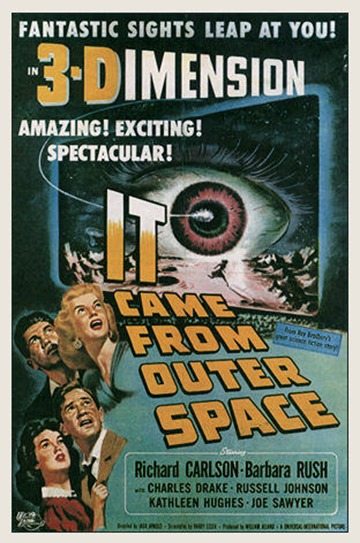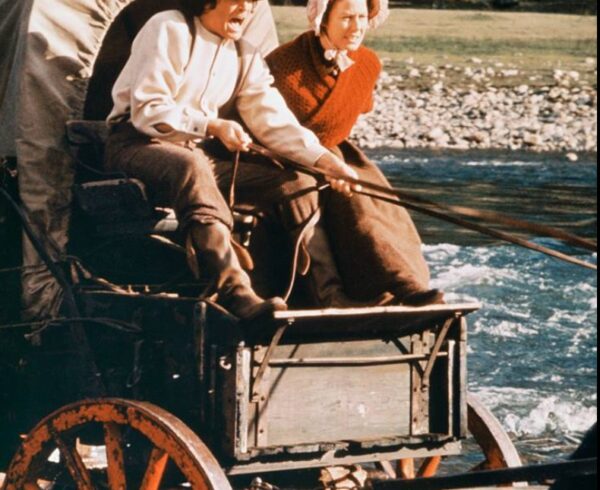The latest version of Stephen King’s IT has creeped into theaters and it looks like we finally have a high profile, studio-produced horror movie that’s actually worth watching. Audiences love it, critics love it, even I pretty much love it, as my own brief, but glowing review attests to.
The Guardian’s James Smythe suggests one of the reasons IT has resonated with so many people over the years is that King “wasn’t writing about the one thing that scared you; he was writing about everything that did… That’s why, in the 30 years since publication, the public’s obsession with It hasn’t really waned. We’re obsessed because we all have fears… This book speaks to everybody.”
Sure, I’ll buy that. But while we’re all listening to IT speak to our darkest fears, let us not forget that IT is hardly the only IT to ever grace a movie screen. There have, in fact, been lots of ITs over the years, each one addressing at least one particular fear. Here’s some of our favorites…
IT CAME FROM OUTER SPACE
Our first IT comes from 1953, courtesy of director Jack Arnold and author Ray Bradbury. One of the many sci-fi films made at the height of the cold war, It Came From Outer Space makes the most of the better-dead-than-red xenophobia spreading throughout the country at that time. Bradbury threw a little twist into his story treatment, though, by having the alien “invaders” turn out to be nothing but stranded travelers just trying to fix their spaceship and go home. It would seem that even immaterial, amorphous blobs are just like us when you get down to it.
IT CAME FROM BENEATH THE SEA
Those with cephalophobia should probably avoid It Came From Beneath The Sea, the film in which a giant octopus develops an unhealthy attraction to the Golden Gate Bridge. For everybody else, however, this is pretty much a must-watch as the titular IT was animated by none other than the legendary Ray Harryhausen. It’s true he cut corners for budgetary reasons and only gave his octopus six arms, but it’s still Harryhausen, so who cares.
IT CONQUERED THE WORLD
Even if It Conquered the World wasn’t Frank Zappa’s favorite B-movie, you’d still want to watch it just for Beluah, the utterly ridiculous upside down cucumber from Venus that Roger Corman tried to pass off as a plausible threat. I mean, how scared can you get when you can actually see the wooden cart the immobile creature is being pushed around on. Still, as ludicrous as the special effects are, there’s actually a hint of seriousness in the screenplay. Beluah’s plot to take over the minds of everyone on Earth taps into the seemingly universal fear of losing one’s identity. Heady stuff for a Corman quickie. Of course, Invasion of the Body Snatchers did the whole loss of self-thing better, but watching Lee Van Cleef team up with a telepathic cucumber has its own undeniable charms.
IT! THE TERROR FROM BEYOND SPACE
Best known these days as one of the acknowledged inspirations for Ridely Scott’s Alien, It! The Terror from Beyond Space is actually a tight little thriller all its own. It may not have Sigourney Weaver or chest-bursting parasites, but it does have a guy in a rubber monster suit blood-sucking alien picking off the crew of a spaceship one by one as they try to get back to Earth. And just like the film it would go on to inspire, this IT! takes advantage of its isolated setting to amp up the cleithrophobia, the fear of being trapped in a small space which you can’t freely leave. Yeah, that’s a pretty specific hang-up, but since there’s no recognized phobia involving guys in rubber monster suits, it’ll have to do.
IT!
Next up is It!, the 1967 film that asks the burning question, “What if Norman Bates had skipped all that killing-women-in-the-shower business and instead resurrected the legendary Golem of Prague to carry out his dastardly deeds?” I know you’re probably thinking the Golem is typically activated to avenge acts of anti-Semitism, but we checked and there’s nothing in the rules that says vindictive gentile weenies can’t make use him as well. Besides, the Bates knock-off this time around is played by the superbly hammy Roddy McDowall, so we’ll cut the movie some slack. Plus, there’s some decent nightmare fuel for those with any type of doomsday phobia, as even nuclear bombs don’t seem to put a dent in the oddly prune-faced Golem once it gets going.
IT’S ALIVE I, II, & III
Moving into the 1970s, our next IT would take on the anxieties of that age by tackling the thorny subjects of pedophobia, birth control, and abortion. True, it did so by having someone crawl around in a mutant baby mask and murder people while looking for its mommy, but the underlying themes are there nonetheless. Releasing the initial chapter of the It’s Alive trilogy barely one year after Roe v Wade, writer/director Larry Cohen uses the somewhat silly set-up to explore the clash between his liberal leanings and his Catholic upbringing. The end result is one of the most oddly pro-life movie series you’ll ever find.
IT FOLLOWS
Finally, we move into the modern day with an IT which the director steadfastly proclaims has no subtext at all, at least none he intended. That hasn’t stopped most of the movie’s audience from reading everything into the story from a morality tale on sexual promiscuity to the horrors of being a rape survivor. And who can blame them? After all, a story about a supernatural curse that is passed from individual to individual through sex kind of lends itself to such interpretations, don’t you think? Don’t worry though. Even if you reject all of the thematic theories floating around, there’s plenty of genophobia on display in It Follows to keep things interesting.
You know, looking back over our list of ITs, you have to admit that’s a whole lot of fear going on. It makes you wonder why we do it, why we keep going to these movies that dredge up our deepest and darkest anxieties. Jeffrey Goldstein, a psychology professor at Utrecht University in the Netherlands, has a few ideas about that. Speaking with CNN, he proposes that part of the appeal of horror movies has to do with resolution.
“Violence in the real world doesn’t always have a satisfactory resolution,” he notes. “One of the appeals of violent entertainment is, you can see a story with a just resolution. When we see justice is done, it reaffirms our belief that justice is possible.”
And if the movie ends ambiguously, like say with It Follows? Well, it still ends, and we can walk out of the theater and leave that horror behind us.
Interestingly enough, the new theatrical version of IT gets to have it both ways. As it sticks to only those parts of King’s novel dealing with the children’s adventures in the sewers beneath Derry, it does have something of a resolution. If there were never any sequel (perish the thought), the film would be nicely self-contained. But as all IT fans know, and the ominous appearance of that Chapter One subtitle at the end of the movie confirms, there is more to the story. IT manages to give us both a satisfying ending and the looming threat of more Pennywise in the future. Oh well, at least we’re able to leave him behind in the theater for now as Prof. Goldstein suggests.
At least until some jerk in the real world starts leaving red balloons on sewer grates, that is, but that’s a different problem altogether.


















